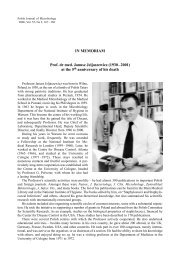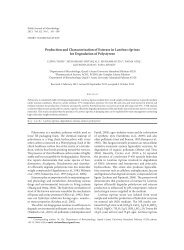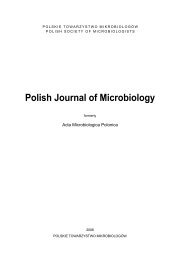No 3 - Polish Journal of Microbiology
No 3 - Polish Journal of Microbiology
No 3 - Polish Journal of Microbiology
Create successful ePaper yourself
Turn your PDF publications into a flip-book with our unique Google optimized e-Paper software.
<strong>Polish</strong> <strong>Journal</strong> <strong>of</strong> <strong>Microbiology</strong><br />
2011, Vol. 60, <strong>No</strong> 3, 229–232<br />
ORIGINAL PAPER<br />
Inhibition <strong>of</strong> Lactophage Activity by Quinolinilporphyrin and Its Zinc Compex<br />
NATALIA VODZINSKA 1 *, BORIS GALKIN 1 , YURIY ISHKOV 1 , ANNA KIRICHENKO 1 ,<br />
ALEXANDRA KONDRATYUK 2 and TETIANA FILIPOVA 2<br />
1 Biotechnological Scientific-Educational Centre <strong>of</strong> I.I. Mechnikov Odessa National University, Odessa, Ukraine<br />
2 Department <strong>of</strong> <strong>Microbiology</strong> and Virology, I.I. Mechnikov Odessa National University, Odessa, Ukraine<br />
Received 28 March 2011, revised 26 June 2011, accepted 5 July 2011<br />
Introduction<br />
Various lactic acid bacteria have been used for centuries<br />
in the preservation and production <strong>of</strong> fermented<br />
foods and feeds <strong>of</strong> plant and animal origins. One <strong>of</strong> the<br />
most critical problems in these processes is the contamination<br />
<strong>of</strong> the starters by bacteriophages that cause<br />
bacterial lysis and leads to failed or slow fermentation,<br />
decrease in acid production, reduction <strong>of</strong> milk products<br />
quality, e.g. taste and texture (C<strong>of</strong>fey and Ross, 2002),<br />
which all result in pr<strong>of</strong>ound economical losses.<br />
Recognition <strong>of</strong> the phage problem in the dairy<br />
industry led to the design and application <strong>of</strong> a variety<br />
<strong>of</strong> practical measures for its alleviation, such as direct<br />
inoculation <strong>of</strong> the starters in closed fermentation vats,<br />
use <strong>of</strong> antiphage media for starter propagation, rotation<br />
<strong>of</strong> starter cultures, application <strong>of</strong> genetic techniques to<br />
improve the phage-resistance <strong>of</strong> starter cultures (however,<br />
European legislation requires the labelling such<br />
<strong>of</strong> starters as GMO that were modified by self-cloning<br />
and thus contain only species-specific DNA) (Kutter<br />
and Sulakvelidze, 2005).<br />
Porphyrins are one <strong>of</strong> the challenging compounds<br />
for infectious disease treatment (Nitzan et al., 1994).<br />
<strong>No</strong>wadays they are widely used in anticancer photodynamic<br />
therapy. This method is based on the use <strong>of</strong><br />
a photosensitizer, which after light exposure can cause<br />
different derangements <strong>of</strong> cell structures. It was shown<br />
Abstract<br />
The influence <strong>of</strong> free base <strong>of</strong> quinolinilporphyrin and its Zn complex on infectivity <strong>of</strong> lactophages E3, E5 and E17 has been studied. The<br />
results <strong>of</strong> our investigations show that inhibition <strong>of</strong> lactophage activity by Zn complex <strong>of</strong> quinolinilporphyrin at concentration 10 μM and<br />
20 μM was in the range 53–62% and 65–85%, respectively. The presence <strong>of</strong> this porphyrin in nutrient medium prevents the propagation<br />
<strong>of</strong> bacteriophage infection in Lactococcus lactis, but does not affect the phage adsorption process. The free base <strong>of</strong> quinolinilporphyrin<br />
slightly inhibits the activity <strong>of</strong> lactophages.<br />
K e y w o r d s: Lactococcus lactis, lactophage, quinolinilporphyrin<br />
that porphyrins have good antibacterial effect even<br />
without activation by light (Philippova et al., 2003).<br />
Porphyrins and their derivatives appear to be effective<br />
virucidal agents in vitro (Cowsert, 1994; Grandadam<br />
et al., 1995). Most <strong>of</strong> the work on viruses in vitro has<br />
been oriented to the use for sterilization <strong>of</strong> blood or<br />
blood products (<strong>No</strong>rth et al., 1993). In some works bacteriophages<br />
were used as a model <strong>of</strong> viruses to study<br />
mechanisms <strong>of</strong> porphyrin action (Zupan et al., 2004;<br />
Vodzinska et al., 2008). These compounds showed good<br />
effect as inhibitors <strong>of</strong> phytoviral infection in plant tissue<br />
culture and in vivo (Krulko et al., 2008; 2009).<br />
The aim <strong>of</strong> this work was to test the ability <strong>of</strong> new<br />
synthetic porphyrins to inhibit the activity <strong>of</strong> lactophages,<br />
namely phage E3, E5 and E17 <strong>of</strong> Lactococus<br />
lactis, without activation by light.<br />
Experemental<br />
Materials and Methods<br />
Bacterial and phage strains. Lactococcus lactis<br />
subsp. lactis 502 and bacteriophages E3, E5 and E17<br />
were obtained from the collection <strong>of</strong> Belarusian State<br />
Technological University. Bacterial strains were grown<br />
and maintained at 30°C in M17 medium (Merck) with<br />
the following composition (Terzaghi and Sandine,<br />
1975) (g/l): peptone from soymeal (5.0), peptone from<br />
* Corresponding author: N. Vodzinska, Biotechnological Scientific-Educational Centre <strong>of</strong> I.I. Mechnikov Odessa National University;<br />
str. Dovzhenko 7а, 65058 Odessa, Ukraine; e-mail: nsvod@ukr.net






